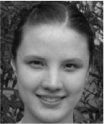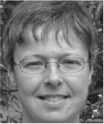Life on Earth. Extremophiles Continue to Move the Goal Posts
Amalie A. H. Pakchung A , Philippa J. L. Simpson A and Rachel Codd A BA Centre for Heavy Metals Research, School of Chemistry, University of Sydney, NSW 2006, Australia.
B Corresponding author. Email: r.codd@chem.usyd.edu.au

Amalie A. H. Pakchung is undertaking her Ph.D. at the School of Chemistry, University of Sydney, on the bioinorganic chemistry of siderophores (high affinity Fe(III) chelators) produced by cold-adapted microorganisms under iron-limited conditions from the extreme environments that exist at the Antarctic and the deep sea. Her early work was presented at the 12th CONNECT Convention of the Royal Australian Chemical Institute, July 2005. |

Philippa J. L. Simpson is completing her Ph.D. thesis on the bioinorganic chemistry of cold-adapted metallo-oxotransferase enzymes at the School of Chemistry, University of Sydney, and presented her work at the 12th CONNECT Convention of the Royal Australian Chemical Institute, July 2005. Her research has been cross-discipline between chemistry and biology, including four months at the School of Biological Sciences, University of East Anglia, studying molecular and microbiological aspects of bacterial nitrogen respiration under Prof. David J. Richardson. |

Rachel Codd is a lecturer in the School of Chemistry at the University of Sydney with her principal research interests lying in the field of bioinorganic chemistry. After periods of postdoctoral research at the University of New South Wales and the University of Arizona, Rachel took up her current position and has initiated research programs in (i) ‘Metalloglycomics’ and (ii) ‘Metallobiomolecules from Antarctic Microorganisms’, the latter which has sparked her wider interest in geomicrobiology and extremophiles. |
Environmental Chemistry 3(2) 77-93 https://doi.org/10.1071/EN05093
Submitted: 1 December 2005 Accepted: 1 February 2006 Published: 5 May 2006
Environmental Context. Since the discovery of a diverse array of microbial life associated with hydrothermal vents on the ocean floor, where conditions are hot, reducing and acidic, scientists have been seeking insight into the mechanisms used by ‘extremophilic’ organisms (those that reside permanently under environmental extremes of temperature (hot or cold), pH (acid or alkaline), salinity, or pressure) to thrive under such seemingly inhospitable conditions.
Abstract. The discovery of an abundance of microorganisms that flourish in a diverse range of environments, from the frigid waters of the Antarctic, to the superheated waters of the hydrothermal vents, at the bottom of 11-km deep ocean trenches and in salt-saturated lakes, has fuelled research aimed to understand the novel survival strategies evolved by these extreme-loving (extremophilic) organisms. Adaptations of biomolecules (proteins, nucleic acids, membranes and small molecules) evolved by extremophiles are wide ranging. Compared with a protein from a ‘regular’ organism, the extremophilic analogue might feature changes to the relative frequencies of amino acid residues that modulate the properties (e.g. conformational flexibility and stability) of the protein under conditions of the specific environmental challenge. The integrity of RNA and DNA from extremophiles may be maintained by subtle structural changes to RNA nucleobases and, in the case of (hyper)thermophiles, the expression of the enzyme reverse gyrase, which catalyses positive DNA supercoiling. The expression of small molecular weight heat-shock or related caretaker proteins also features as a common adaptive strategy for maintaining cell viability at environmental extremes. Membrane architecture in extremophiles can be modulated by the environmental temperature, with additional thermal stability in membranes from some hyperthermophiles conferred by novel (cyclised) lipid chains. In addition, a selection of osmolytes and small molecules are biosynthesised or sequestered by extremophilic organisms that have adapted to conditions of high salt and/or micronutrient deprivation.
Keywords. : biomolecular adaptation — biotechnology — geomicrobiology — metals
Acknowledgements
This work was supported by an Australian Antarctic Science Grant (Number 2547) (RC) and a 2003 Australian Antarctic Science ‘Top-up’ Scholarship (PJLS). Additional support from a University of Sydney Research and Development Grant (2005) (RC) and postgraduate scholarships (APA: PJLS; UPA (co-funded): AAHP) is also gratefully acknowledged.
[1]
R. F. Weiss,
P. Lonsdale,
J. E. Lupton,
A. E. Bainbridge,
H. Craig,
Nature 1977, 267, 600.
| Crossref | GoogleScholarGoogle Scholar |
| Crossref | GoogleScholarGoogle Scholar |
| Crossref | GoogleScholarGoogle Scholar |
| Crossref | GoogleScholarGoogle Scholar |
| Crossref | GoogleScholarGoogle Scholar |
| Crossref | GoogleScholarGoogle Scholar |
| Crossref | GoogleScholarGoogle Scholar |
| Crossref | GoogleScholarGoogle Scholar |
| Crossref | GoogleScholarGoogle Scholar |
| Crossref | GoogleScholarGoogle Scholar |
| Crossref | GoogleScholarGoogle Scholar |
| Crossref | GoogleScholarGoogle Scholar |
| Crossref | GoogleScholarGoogle Scholar |
| Crossref | GoogleScholarGoogle Scholar |
| Crossref | GoogleScholarGoogle Scholar |
| Crossref | GoogleScholarGoogle Scholar |
| Crossref | GoogleScholarGoogle Scholar |
| Crossref | GoogleScholarGoogle Scholar |
| Crossref | GoogleScholarGoogle Scholar |
| Crossref | GoogleScholarGoogle Scholar |
| Crossref | GoogleScholarGoogle Scholar |
| Crossref | GoogleScholarGoogle Scholar |
| Crossref | GoogleScholarGoogle Scholar |
| Crossref | GoogleScholarGoogle Scholar |
| Crossref | GoogleScholarGoogle Scholar |
| Crossref | GoogleScholarGoogle Scholar |
| Crossref | GoogleScholarGoogle Scholar |
| Crossref | GoogleScholarGoogle Scholar |
| Crossref | GoogleScholarGoogle Scholar |
| Crossref | GoogleScholarGoogle Scholar |
| Crossref | GoogleScholarGoogle Scholar |
| Crossref | GoogleScholarGoogle Scholar |
| Crossref | GoogleScholarGoogle Scholar |
| Crossref | GoogleScholarGoogle Scholar |
| Crossref | GoogleScholarGoogle Scholar |
| Crossref | GoogleScholarGoogle Scholar |
| Crossref | GoogleScholarGoogle Scholar |
| Crossref | GoogleScholarGoogle Scholar |
| Crossref | GoogleScholarGoogle Scholar |
| Crossref | GoogleScholarGoogle Scholar |
| Crossref | GoogleScholarGoogle Scholar |
| Crossref | GoogleScholarGoogle Scholar |
| Crossref | GoogleScholarGoogle Scholar |
| Crossref | GoogleScholarGoogle Scholar |
| Crossref | GoogleScholarGoogle Scholar |
| Crossref | GoogleScholarGoogle Scholar |
| Crossref | GoogleScholarGoogle Scholar |
| Crossref | GoogleScholarGoogle Scholar |
| Crossref | GoogleScholarGoogle Scholar |
| Crossref | GoogleScholarGoogle Scholar |
| Crossref | GoogleScholarGoogle Scholar |
| Crossref | GoogleScholarGoogle Scholar |
| Crossref | GoogleScholarGoogle Scholar |
| Crossref | GoogleScholarGoogle Scholar |
| Crossref | GoogleScholarGoogle Scholar |
| Crossref | GoogleScholarGoogle Scholar |
| Crossref | GoogleScholarGoogle Scholar |
| Crossref | GoogleScholarGoogle Scholar |
| Crossref | GoogleScholarGoogle Scholar |
| Crossref | GoogleScholarGoogle Scholar |
| Crossref | GoogleScholarGoogle Scholar |
| Crossref | GoogleScholarGoogle Scholar |
| Crossref | GoogleScholarGoogle Scholar |
| Crossref | GoogleScholarGoogle Scholar |
| Crossref | GoogleScholarGoogle Scholar |
| Crossref | GoogleScholarGoogle Scholar |
| Crossref | GoogleScholarGoogle Scholar |
| Crossref | GoogleScholarGoogle Scholar |
| Crossref | GoogleScholarGoogle Scholar |
| Crossref | GoogleScholarGoogle Scholar |
| Crossref | GoogleScholarGoogle Scholar |
| Crossref | GoogleScholarGoogle Scholar |
| Crossref | GoogleScholarGoogle Scholar |
| Crossref | GoogleScholarGoogle Scholar |
| Crossref | GoogleScholarGoogle Scholar |
| Crossref | GoogleScholarGoogle Scholar |
| Crossref | GoogleScholarGoogle Scholar |
| Crossref | GoogleScholarGoogle Scholar |
| Crossref | GoogleScholarGoogle Scholar |
| Crossref | GoogleScholarGoogle Scholar |
| Crossref | GoogleScholarGoogle Scholar |
| Crossref | GoogleScholarGoogle Scholar |
| Crossref | GoogleScholarGoogle Scholar |
| Crossref | GoogleScholarGoogle Scholar |
| Crossref | GoogleScholarGoogle Scholar |
| Crossref | GoogleScholarGoogle Scholar |
| Crossref | GoogleScholarGoogle Scholar |
| Crossref | GoogleScholarGoogle Scholar |
| Crossref | GoogleScholarGoogle Scholar |
| Crossref | GoogleScholarGoogle Scholar |
| Crossref | GoogleScholarGoogle Scholar |
| Crossref | GoogleScholarGoogle Scholar |
| Crossref | GoogleScholarGoogle Scholar |
| Crossref | GoogleScholarGoogle Scholar |
| Crossref | GoogleScholarGoogle Scholar |
| Crossref | GoogleScholarGoogle Scholar |
| Crossref | GoogleScholarGoogle Scholar |
| Crossref | GoogleScholarGoogle Scholar |
| Crossref | GoogleScholarGoogle Scholar |
| Crossref | GoogleScholarGoogle Scholar |
| Crossref | GoogleScholarGoogle Scholar |
| Crossref | GoogleScholarGoogle Scholar |
| Crossref | GoogleScholarGoogle Scholar |
| Crossref | GoogleScholarGoogle Scholar |
| Crossref | GoogleScholarGoogle Scholar |
| Crossref | GoogleScholarGoogle Scholar |
| Crossref | GoogleScholarGoogle Scholar |
| Crossref | GoogleScholarGoogle Scholar |
| Crossref | GoogleScholarGoogle Scholar |
| Crossref | GoogleScholarGoogle Scholar |
| Crossref | GoogleScholarGoogle Scholar |
| Crossref | GoogleScholarGoogle Scholar |
| Crossref | GoogleScholarGoogle Scholar |
| Crossref | GoogleScholarGoogle Scholar |
| Crossref | GoogleScholarGoogle Scholar |
| Crossref | GoogleScholarGoogle Scholar |
| Crossref | GoogleScholarGoogle Scholar |
| Crossref | GoogleScholarGoogle Scholar |
| Crossref | GoogleScholarGoogle Scholar |
| Crossref | GoogleScholarGoogle Scholar |
| Crossref | GoogleScholarGoogle Scholar |
| Crossref | GoogleScholarGoogle Scholar |
| Crossref | GoogleScholarGoogle Scholar |
| Crossref | GoogleScholarGoogle Scholar |
| Crossref | GoogleScholarGoogle Scholar |
| Crossref | GoogleScholarGoogle Scholar |
| Crossref | GoogleScholarGoogle Scholar |
| Crossref | GoogleScholarGoogle Scholar |
| Crossref | GoogleScholarGoogle Scholar |
| Crossref | GoogleScholarGoogle Scholar |
| Crossref | GoogleScholarGoogle Scholar |
| Crossref | GoogleScholarGoogle Scholar |
| Crossref | GoogleScholarGoogle Scholar |
| Crossref | GoogleScholarGoogle Scholar |
| Crossref | GoogleScholarGoogle Scholar |
| Crossref | GoogleScholarGoogle Scholar |
| Crossref | GoogleScholarGoogle Scholar |
| Crossref | GoogleScholarGoogle Scholar |
| Crossref | GoogleScholarGoogle Scholar |
| Crossref | GoogleScholarGoogle Scholar |
| Crossref | GoogleScholarGoogle Scholar |
| Crossref | GoogleScholarGoogle Scholar |
| Crossref | GoogleScholarGoogle Scholar |
| Crossref | GoogleScholarGoogle Scholar |
| Crossref | GoogleScholarGoogle Scholar |
| Crossref | GoogleScholarGoogle Scholar |
| Crossref | GoogleScholarGoogle Scholar |
| Crossref | GoogleScholarGoogle Scholar |
| Crossref | GoogleScholarGoogle Scholar |
| Crossref | GoogleScholarGoogle Scholar |
| Crossref | GoogleScholarGoogle Scholar |



